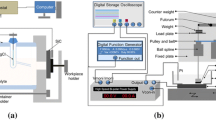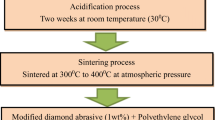Abstract
The application field of silicon carbide (SiC) as a next-generation compound semiconductor is expanding because of its significant advantages: high power, high frequency, low coefficient of thermal expansion, and high thermal conductivity. Many researchers have investigated SiC polishing for the manufacturing of semiconductor substrates using SiC. However, because SiC is a chemically and mechanically stable material, these researchers have faced difficulties due to its very low polishing rate (95–540 nm/h). Therefore, methods are required for increasing the material removal rate of SiC. The aim of this study was to investigate the increase in removal rate during the polishing of single-crystal SiC subjected to simultaneous polishing and dressing by using a diamond-impregnated polishing pad. Two types of pads—containing 1 and 5 wt% nanodiamond—were fabricated, and their performances were compared with that of a polyurethane polishing pad. A novel arrangement of conditioners was created in brazed diamond patterns, which were radially arranged in a cluster with 3–4 grits per cluster. Furthermore, a combined diamond disk was developed. The surface characteristics of the nanodiamond-impregnated pads, as well as the surface roughness, surface damage, and removal rate of the SiC polished with these pads and diamond disks, were investigated and compared with the corresponding attributes displayed by a polyurethane polishing pad and a conventional diamond disk. Experimental results showed that the removal rate of SiC with dressing was approximately 73 % higher than that of without dressing. The novel conditioner resulted in a dressing rate approximately two times higher and a removal rate approximately 38 % higher than those obtained by using the conventional diamond disk. In addition, SiC polishing tests revealed that the nanodiamond-impregnated polishing pads provided better surface roughness with no damage, as well as a removal rate approximately 2.5 times higher than that provided by the polyurethane polishing pad.
Similar content being viewed by others
References
Su J, Du J, Liu H, Liu X (2011) Research on material removal rate of CMP 6H-SiC crystal substrate (0001) Si surface based on abrasive alumina (Al2O3). Procedia Eng 24:441–446
Huo FW, Guo DM, Kang RK, Feng G (2012) Nanogrinding of SiC wafers with high flatness and low subsurface damage. Trans Nonferrous Metals Soc China 22:3027–3033
Shi X, Pan G, Zhou Y, Zou C, Gong H (2013) Extended study of the atomic step-terrace structure on hexagonal SiC (0001) by chemical mechanical planarization. Appl Surf Sci 284:195–206
Kikuchi M, Takahashi Y, Suga T, Suzuki S, Bando Y (1992) Mechanical chemical polishing of silicon carbide single crystal with chromium(III) oxide abrasive. J Am Ceram Soc 75:189–194
Zhou L, Audurier V, Pirouz P, Powell JA (1997) Chemomechanical polishing of silicon carbide. J Electrochem Soc 144:L161–L163
Neslen CL, Mitchel WC, Hengehold RL (2001) Effects of process parameter variations on the removal rate in chemical mechanical polishing of 4H-SiC. J Electron Mater 30(10):1271–1275
Zhu Z, Muratov V, Fischer M (1999) Tribochemical polishing of silicon carbide in oxidant solution. Wear 225–229:848–856
Kuo P, Currier I (2006) Augmented CMP techniques for silicon carbide. Mater Sci Forum 527–529:1099–1102
Lee HS, Kim DI, An JH, Lee HJ, Kim KH, Jeong H (2010) Hybrid polishing mechanism of single crystal SiC using mixed abrasive slurry. CIRP Ann Manuf Technol 59:333–336
Yamamura K, Takiguchi T, Ueda M, Deng H, Hattori AN, Zettsu N (2011) Plasma assisted polishing of single crystal SiC for obtaining atomically flat strain-free surface. CIRP Ann Manuf Technol 60:571–574
Kubota A, Yoshimura M, Fukuyama S, Iwamoto C, Touge M (2012) Planarization of C-face 4H-SiC substrate using Fe particles and hydrogen peroxide solution. Precision Eng 36:137–140
Tsai MY, Chen WK (2011) Effect of CMP conditioner diamond shape on Pad topography and oxide wafer performances. Int J Adv Manuf Technol 55:253–262
Yeh HM, Chen KS (2010) Development of a pad conditioning simulation module with a diamond dresser for CMP application. Int J Adv Manuf Technol 50:1–12
Tso PL, Ho SY (2007) Factors influencing the dressing rate of chemical mechanical polishing pad conditioning. Int J Adv Manuf Technol 123:107–113
Jeng YR, Huang PY (2005) A material removal rate model considering interfacial micro-contact wear behavior for chemical mechanical polishing. J Tribol 127:190–197
Harsha AP, Tewari US (2003) Two-body and three-body abrasive wear behavior of polyaryletherket-one composites. Polym Test 22(4):403–418
Seo YJ, Lee WS, Yeh P (2004) Improvements of oxide-chemical mechanical polishing performances and aging effect of alumina and silica mixed abrasive slurries. Microelectron Eng 75:361–366
Bibby TFA, Adams JA, Holland K, Krulik GA, Parikh P (1997) CMP CoO reduction: Slurry reprocessing. Thin Solid Films 308–309:538–542
Author information
Authors and Affiliations
Corresponding author
Rights and permissions
About this article
Cite this article
Tsai, M.Y., Wang, S.M., Tsai, C.C. et al. Investigation of increased removal rate during polishing of single-crystal silicon carbide. Int J Adv Manuf Technol 80, 1511–1520 (2015). https://doi.org/10.1007/s00170-015-7023-4
Received:
Accepted:
Published:
Issue Date:
DOI: https://doi.org/10.1007/s00170-015-7023-4




